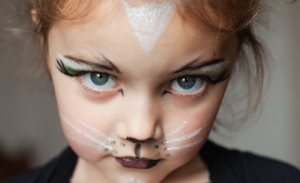Itchy costumes, crowded streets and a loud atmosphere can make your little one’s Halloween not so trick-or-treaty, especially if they are sensory-sensitive. However, there are ways to make this spooky holiday more comfortable this year for you and your little goblins.
ABOUT SENSORY ACTIVITIES
Sensory activities — anything that involves the five senses — can have a positive impact on your little bundle of joy from day one. The earlier you introduce them, the better. Singing songs, ooey-gooey playdough, bubbles or a homemade mess-free sensory bin with kinetic sand are ideal for building your baby’s motor skills.
“It gives children a greater awareness,” says Holly Young, owner of Puzzle Pieces in Cincinnati, a store specializing in sensory toys for special needs and autism. “Children absorb things around them, and it desensitizes things as they grow.
While sensory activities stimulate one or more of the five senses, they also encourage motor development, Young says. And the options are endless, allowing babies and children to explore the big world around them through touch, sound and more. And sensory activities are good for both typical and atypical sensory-sensitive children; the way you engage in sensory play with them is the same.
“The way that babies learn is the way atypical children learn, so back to ground zero,” says Young. It’s about restructuring the way they think and the way they play.
SENSORY DISORDERS
Sensory disorders come in many shapes and sizes, and sometimes it can be difficult to grasp. Some children with autism or ADHD are sensory sensitive; others struggle with Sensory Processing Disorder (SPD) or sensory integration dysfunction, causing them to be over or under sensitive to one or more of the five senses. For example, they may have little reaction to pain, uncontrolled body movements, or may be overwhelmed by sounds. Sarah Lyons, mom of four, says her daughter was diagnosed with SPD as a toddler. Looking back, Lyons says her child may have had SPD even earlier.
“I can think back to many issues she had as a baby that were related to SPD,” Lyons says. “She refused to bare weight on her legs, but instead wanted them curled up to her body; she had physical therapy to work on this at 11 months old.”
Baby’s and toddlers with SPD or who are sensory sensitive can improve their sensory tolerance over the years with physical therapy and sensory activities with caregivers. Lyons found ways to help her little girl improve by signing her up for soccer and playing soft music.
“Providing her with physical activity helps my child greatly,” Lyons says. “She also has a weighted blanket she uses if she needs to calm down. Music helps her, and we have an agreement that if she goes to her room alone and turns on her music, it’s because she needs that time to unwind.”
3 SIMPLE WAYS TO A CALMER HALLOWEEN
Halloween can be a difficult time for sensory-sensitive children. Here are three simple ways to make this month more tolerable:
1. Seek Our Sensory-friendly Trick-or-Treating. Go to places that are quiet with less lights and not as spooky as other sites. Some churches, malls or shopping centers hold free Halloween events for families who don’t want to go trick-or-treating. Puzzle Pieces holds a free event prior on Saturday, Oct. 27 from 6 – 7:30 p.m. Fun includes door prizes, kid-friendly crafting and candy handouts. The sensory room will be open. For details, e-mail holly@autismspuzzlepieces.com.
2. Avoid Itchy Costumes. Dress up your little ones by adding a little creative flare to their comfortable clothing. Pin on a cute flower, add a simple prop, or let them go out in their most comfy pajamas.
3. Plan and Prepare. Planning and preparation are key to helping your child feel comfortable. Have your ducks in a row and have outfits ready, know when and where you are going and communicate clearly with your child so he knows what to expect.





